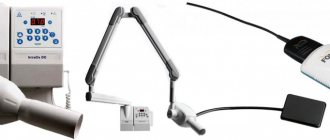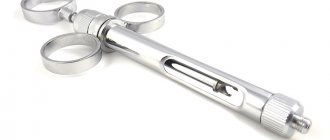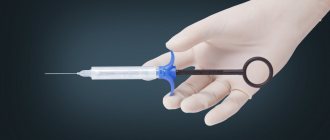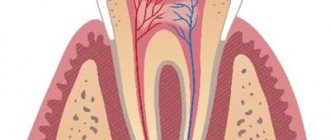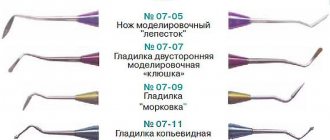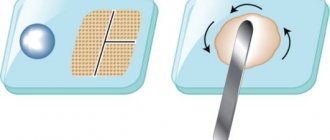Effective isolation of the working field
Such a dental device as a rubber dam has been known for quite a long time. In 1861, the GoodYear Company invented the vulcanization process. Just three years later, this technology found its way into dentistry: a certain Dr. Barnum came up with the idea of using a rubber scarf to isolate teeth during treatment. This moment can be considered the “birthday” of the rubber dam.
The use of a rubber dam has numerous advantages: it guarantees isolation from microorganisms, protects the patient from aspiration of instruments and detritus, and from contact with the mucous membrane of aggressive solutions and materials, and also protects the doctor from microorganisms and unpleasant odor from the patient’s mouth.
The following are counterarguments to the use of rubber dam:
- difficulty breathing for the patient;
- restriction of the patient's freedom of movement;
- inconvenience of applying the entire structure;
- the need to use hard steel clasps, which injure the hard tissues of the tooth.
There are many techniques for applying a rubber dam, and this often confuses doctors. The most common are two main methods.
According to the first of them, the selected clasp is fixed on the most distal tooth, after which the scarf, with the help of an assistant, is pulled first onto the clasp and then onto the frame.
The second method of applying a rubber dam is to make a hole in the latex scarf using a hole punch and then fix it on the frame. Subsequently, the required clasp is inserted into the hole in the scarf and the entire structure is applied to the most distally located tooth of those to be treated (Fig. 1).
Rice. 1
This method of applying a rubber dam is simpler and more common due to the fact that only a doctor works in the oral cavity (without an assistant). However, despite all the advantages of the above method, various difficulties and errors in application necessitated further optimization. This is how Kerr's OptiDam™ system was born and offers significant benefits.
First of all, the unusual three-dimensional design of OptiDam™ attracts attention. The idea of creating a 3D scarf for a rubber dam is driven by the need to reduce the pre-tension of the system.
This means that, in theory, OptiDam™ can be used without molar clasps, since the latex scarf lies passively in the mouth. While excessive tension on the scarf requires a rigid clasp to securely fix it, the absence of such tension allows one to avoid injury to hard and soft tissues.
The asymmetrical 3D shape of OptiDam™ Posterior (for posterior teeth) is no coincidence. The space in the area of the teeth to be treated is increased, which prevents accidental movement of the scarf due to unintentional movements of the doctor or patient (Fig. 2).
Rice. 2
In addition, sufficient space is also required for saliva removal by an assistant or a passively inserted saliva ejector into the oral cavity (Fig. 3), so the OptiDam™ does not take up too much space in the oral cavity on the side opposite to the intervention. At the same time, the scarf opens the corners of the patient’s lips, facilitating oral breathing.
Rice. 3
All these benefits are achieved not only due to the three-dimensional design of the scarf, but also thanks to the adjustable frame. The OptiDam™ frame is designed in such a way that its outline follows the lines of the lips when the mouth is open, its oval shape provides freedom of movement for the doctor and makes treatment more comfortable for the patient (Fig. 4).
Rice. 4
In addition, in the sagittal plane, the 3D contours of the frame also follow the contours of the face.
In the nose area, the rubber dam frame has a concave section, which facilitates nasal breathing for the patient. The pointed protrusions designed to secure the scarf in the OptiDam™ system are moved to special recesses on the frame, which eliminates the possibility of accidental injury. During treatment, this lip design makes it easier to collect various liquids that would normally splash onto the patient due to careless movements.
OptiDam™ Anterior (for the anterior group of teeth) has a symmetrical shape, as this is necessary to eliminate excess tension in the premolar area, in addition, it allows patients to move the lips away from the working field, and also ensures optimal aesthetics of restorations (Fig. 5).
Rice. 5
Thanks to the presence of special “papillae” on the surface of OptiDam™, located in the right place and having the right dimensions, the procedure for making holes in the rubber dam scarf becomes simple and predictable: in order to make a hole in the scarf, you simply need to cut off the top of the “papilla” using sharp scissors . The remaining uncut edges of the papilla face the gum and, when a rubber dam is applied, are immersed in the dental-gingival sulcus.
The depth of immersion depends on the height at which the top of the “papilla” was cut off. The advantages are easy gum retraction and the formation of a valve zone around the neck of the tooth, which is especially important in the anterior region, as it facilitates further modeling of the restoration.
Often, an objective determination of the color of the teeth becomes impossible after the application of a rubber dam due to their drying, however, the blue color of the scarf contributes to a more differentiated assessment of color, and also has a relaxing effect for the doctor’s eyes and increases the contrast of perception (Fig. 6).
Rice. 6
The application procedure for OptiDam™ Anterior is very simple. After making a hole of the required size, the scarf is put on a frame and usually fixed on the teeth symmetrically on opposite sides. The correct distance between the holes, as well as the sliding effect in a humid environment, facilitate the process of positioning the interdental septa of the scarf using floss (Fig. 7).
Rice. 7
To fix a rubber dam in the premolar area, a clasp is not always required: tying it with floss or using other auxiliary materials can solve this problem (Fig. 5). To immerse the edges of the scarf, located around the holes made, into the gingival sulcus, you can use an air gun (puster).
In difficult clinical situations, such as non-standard tooth position or the presence of a tooth defect below the gum level, the so-called adhesive technique is used. In these cases, the papillae on the scarf are not cut off, but with the help of scissors a long narrow incision is made along the dentition. Using tissue adhesive (Histoacryl®), the rubber dam is glued to the gum tissue on the vestibular and oral sides (Fig. 8).
Rice. 8
Once treatment is completed, the rubber dam is removed from the mouth without causing any damage to the soft tissue. In order to make the above incision in the correct place, the papillae on the scarf are used as a guide (Fig. 9): to ensure a tight fit of the rubber dam to the gum, the incision is placed along the buccal surface of the papillae. Thus, the possibilities of using a rubber dam are not limited to the placement of individual fillings, but also extend to more complex restoration techniques.
Rice. 9
“Upper” and “Lower” modifications of OptiDam™ Anterior are available with different papilla locations for the upper and lower dentition, which allows you to simultaneously apply a rubber dam to the anterior teeth of both jaws. This procedure was practically impossible with a conventional dental dam, so we can say that the OptiDam™ system opens up new possibilities, especially in the field of professional teeth whitening, since when using products with a peroxide content of up to 40%, complete isolation of the gums is a necessary condition. In addition, thanks to the concave edges of the holes in the scarf, the OptiDam™ system allows you to isolate a greater height of the clinical crown of the tooth (compared to traditional systems), which until now seemed impossible.
The use of OptiDam™ Posterior (for posterior teeth) does not differ significantly from traditional techniques, but it is significantly simplified due to the advantages described above (Fig. 10).
Rice. 10
If a clasp is used, we recommend (as when using any type of rubber dam) to pre-stretch the hole made in the scarf for passive insertion of the clasp. The range of possibilities is not limited to single restorations and includes more complex treatment techniques, such as adhesive fixation of metal-free prosthetics (Fig. 11).
Rice. eleven
The patient's comfort-oriented design and simplified application method make the rubber dam application procedure more enjoyable and safe even for an experienced specialist, and allow the novice to avoid the most common difficulties.
Clinical picture
The intensity of pain in this disease can be very different: insignificant, arising as a result of exposure to thermal factors, and acute paroxysmal, causing genuine horror in the patient. Treatment of tooth pulpitis depends on clear symptoms. The severity of pain divides the disease into two conventional categories.
Acute form
This form is characterized by intense, acute and paroxysmal pain, intensifying at night. If you ignore the disease, pain increases, and pain-free periods shorten. Often pain appears on its own, even without the action of irritating factors. During the period of absence of pain, discomfort may arise due to exposure to thermal factors, for example, cool or hot food. The pain remains for another 10-15 minutes after the irritating factor has been eliminated (this characteristic helps differentiate inflammation of the neurovascular bundles of the tooth from carious processes).
In the case of caries, the pain recedes along with the irritating factor. Often, the patient is unable to accurately point to the tooth that hurts, since pain impulses seep through all the nerve trunks. Due to the smooth transition of serous inflammation to purulent inflammation, pain also increases. During the progression of purulent inflammatory processes, the pain becomes constant: there are no painless intervals.
Chronic form
In this case, the inflammatory process is not expressed. Often a person feels a slight aching pain in the teeth, which most often appears due to the action of cold and hot food. Sometimes there is no pain at all. This form of the disease can develop into an acute form: at this time the pain becomes especially pronounced.
Cofferdam - what is it and why is it used in dental treatment?
Treatment of dental diseases requires increased attention and concentration on the part of not only the doctor, but also the patient himself. To make this process as simple, fast and painless as possible, specialists use many different devices, one of which is a rubber dam. This is a small latex pad with which the doctor isolates the treated area from the moist environment of the oral cavity. Read further in our article about why a rubber dam is needed in dentistry and how to use it correctly.
Does the device have any disadvantages?
Despite such an impressive list of advantages, rubber dams are also characterized by some negative aspects. So, for example, in very rare cases a patient develops an allergic reaction to the material. In other situations, the doctor may accidentally damage the interdental papillae, but this only happens if the technique of applying the rubber dam is violated. In addition, today in dentistry there are quite a few types of insulating onlays, which allows you to choose the material that is optimally suited for each specific case.
Treatment methods for pulpitis
Modern dentists use the depulpation method: the inflamed nerve is completely removed, then the dentist expands the cavity and performs a filling. If the patient is young and consults a dentist at the onset of the disease, other types of therapy can be used to preserve the living pulp. Dentists prefer to preserve the natural dental pulp, because after its removal, the shade of the tooth changes to grayish, and the strength deteriorates somewhat. It is often impossible to preserve the pulp in its original form, since patients make an appointment with the dentist already at the height of the acute form, when only surgical treatment is possible. The pulp preservation method is also relevant for young people: conservative treatment is often successful in patients under 25-27 years of age.
We will consider the treatment of pulpitis below in the article. By the way, according to statistics, approximately 60-70% of cases of treatment for this disease are carried out poorly and require repeated therapy.
The effectiveness of antibiotics and folk remedies
Pulpitis is a complication of carious processes that occurs as a result of infectious agents entering the tooth pulp. Caries is an irreversible process that can only be treated by drilling out rotten tissue. Experiments indicate that the microflora that causes caries is highly resistant to any antibiotics. For example, resistance to ampicillin is 99.99%, and to lincomycin - 95%. If bacteria have such a high resistance to antibiotics, then the use of “miracle” herbs and rinses is not even worth talking about.
In what situations do you use a rubber dam?
The protective lining is recommended for use in most dental procedures. All of them can be divided into three main groups:
- canal treatment: when it comes to root canal treatment, it is necessary to ensure perfect dryness and isolation - the success of the treatment largely depends on this,
- filling and restoration: usually a rubber dam is used when using light-curing materials,
- whitening: sometimes specialists use isolation during professional enamel whitening, but this is not always justified.
Rubber dam is used for various methods of dental treatment and restoration.
Thus, such an onlay can be used for almost any type of dental treatment. The choice of the type of rubber dam system directly depends on the planned procedure.
What are the restrictions on use?
Despite such a wide range of applications, the material also has contraindications. Dental experts identify two main limitations to its use:
- difficulty breathing through the nose - with such latex insulation you will not be able to breathe through the mouth,
- allergy to the material and its components.
The last problem is easily solved - you just need to warn your dentist in time about the presence of this contraindication. In this case, the doctor may suggest one of the suitable types of rubber dam.
